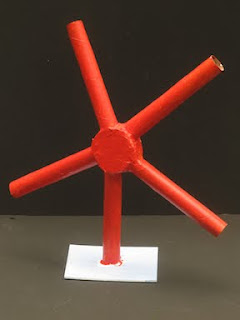
In previous posts, I've written about the process of creating a toned-paper charcoal drawing. High school students made animal drawings, and Jen drew her Scotty dog, Molly, by first applying charcoal all over the paper, and then drawing lines on top of that layer with soft charcoal. Next, tones or values of gray were added and blended, and a kneaded eraser was used to remove charcoal to gradually create lighter values or whites.
I love teaching this flexible method of drawing to both children and adults, because it's so easy to make changes in your drawing this way. It's a thoughtful process of making judgements about the "darkness" and "lightness" you want to show. Sometimes the color of an object makes it confusing as to how the light source is affecting it. That's why I like this technique of drawing groups of white objects on a white cloth. It helps the artist concentrate on light and shadow, and therefore helps to achieve three-dimensionality.
"How do I make it look real?" There are no fancy tricks. It's all about taking your time to make careful observations, critical judgements and keeping an open mind. My students often spend several hours working on white-on-white drawings, and they're invariably happy with the results.
WHITE-ON-WHITE DRAWING FROM OBSERVATION
Materials:
White drawing paper of good quality, 16"x20" or 18"x24"
Paper towels
Procedure:
1. Set up a group of white objects on a table with strong light from a lamp on one side. Consider using white eggs, white cups or bowls, white boxes, etc., and arrange them on a white cloth with a white background.
2. What to look for before you begin:
*Notice how the shapes of the shadows form around the objects and lead your eye from one thing to the next.
*Notice how it's the value (degree of darkness) that separates one object from another, not dark "outlines."
*Be open to seeing not only the shadows cast on the tabletop, but also the shadows on the actual objects.
3. Now tone your paper: using the side of a short piece of charcoal, make broad, dark strokes on the paper, evenly covering the whole surface. It helps to work on top of a pad of paper for smooth application.
4. Using a paper towel, gently smooth and blend the charcoal as evenly as possible all over the paper. If too much charcoal is removed, just apply more, and smooth it again.
5. Draw light lines with your charcoal, and make decisions and changes as you go, always comparing the size and placement of drawn objects to what you actually see in front of you.
6. Start putting in large areas of darks where you see then in the set-up. Keep comparing and varying the degree of darkness to approximate as closely as possible what you see. Sometimes you need to do more looking than drawing!
7. "Pull out" any light areas you see, using your finger tips or your eraser. You can squeeze the kneaded eraser into pointed or knife-edged shapes to erase small areas that are hard to reach with fingers.
8. You can work back and forth from dark to light and vice-versa, until you are finished. When all your objects look consistently lit from one side, and all the shadows are consistently cast on the opposite side, your drawing will look convincingly three-dimensional.
9. In a well ventilated area, or outside, spray your drawing lightly with fixative to prevent smudging.
I can't overemphasize how important it is to allow yourself the time to really look at your set-up of objects and be open to changing your mind about your drawing, or comparing degrees of darkness. Keep looking!

Amy with her white-on-white drawing - beautiful work!























































